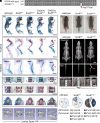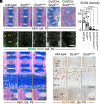Variants in the SOX9 transactivation middle domain induce axial skeleton dysplasia and scoliosis
- PMID: 39854231
- PMCID: PMC11789016
- DOI: 10.1073/pnas.2313978121
Variants in the SOX9 transactivation middle domain induce axial skeleton dysplasia and scoliosis
Abstract
SOX9 is a crucial transcriptional regulator of cartilage development and homeostasis. Dysregulation of SOX9 is associated with a wide spectrum of skeletal disorders, including campomelic dysplasia, acampomelic campomelic dysplasia, and scoliosis. Yet how SOX9 variants contribute to the spectrum of axial skeletal disorders is not well understood. Here, we report four pathogenic variants of SOX9 identified in a cohort of patients with congenital vertebral malformations. We report a pathogenic missense variant in the transactivation middle (TAM) domain of SOX9 associated with mild skeletal dysplasia and scoliosis. We isolated a Sox9 mutant mouse with an in-frame microdeletion in the TAM domain (Sox9Asp272del), which exhibits skeletal dysplasia including kinked tails, rib cage anomalies, and scoliosis in homozygous mutants. We find that both the human missense and the mouse microdeletion mutations resulted in reduced SOX9 protein stability in cell culture, while Sox9Asp272del mutant mice show decreased SOX9 expression in the growth plate and annulus fibrosus tissues of the spine. This reduction in SOX9 expression was correlated with the reduction of extracellular matrix components, such as tenascin-X and the Adhesion G-protein coupled receptor ADGRG6. In summary, our work identified and modeled a pathologic variant of SOX9 within the TAM domain and demonstrated its importance for SOX9 protein stability. Our work demonstrates that SOX9 stability is important for the regulation of ADGRG6 expression, which is a known regulator of postnatal spine homeostasis, underscoring the essential role of SOX9 dosage in a spectrum of axial skeleton dysplasia in humans.
Keywords: SOX9 (SRY-Box 9); campomelic dysplasia; congenital vertebral malformations; scoliosis; skeletal dysplasia.
Conflict of interest statement
Competing interests statement:The authors declare no competing interest.
Figures








Update of
-
Variants in the SOX9 transactivation middle domain induce axial skeleton dysplasia and scoliosis.medRxiv [Preprint]. 2023 May 30:2023.05.29.23290174. doi: 10.1101/2023.05.29.23290174. medRxiv. 2023. Update in: Proc Natl Acad Sci U S A. 2025 Jan 28;122(4):e2313978121. doi: 10.1073/pnas.2313978121. PMID: 37398377 Free PMC article. Updated. Preprint.
References
-
- Sugimoto Y., et al. , Scx+/Sox9+ progenitors contribute to the establishment of the junction between cartilage and tendon/ligament. Development 140, 2280–2288 (2013). - PubMed
MeSH terms
Substances
Grants and funding
- 2021-I2M-1-052/CAMS Innovation Fund for Medical Sciences
- 2022-PUMCH-C-033/National High-Level Hospital Clinical Research Funding
- start-up funding/University of Southern California (SC)
- 81874022 82172483/MOST | National Natural Science Foundation of China (NSFC)
- R00 AR077090/AR/NIAMS NIH HHS/United States
- R01 AR072009/AR/NIAMS NIH HHS/United States
- 82172382/MOST | National Natural Science Foundation of China (NSFC)
- ZR202102210113/Shandong Natural Science Foundation
- 82072391/MOST | National Natural Science Foundation of China (NSFC)
- 2022YFC2703102/MOST | National Key Research and Development Program of China (NKPs)
- R01AR072009/HHS | NIH | National Institute of Arthritis and Musculoskeletal and Skin Diseases (NIAMS)
- 81930068/MOST | National Natural Science Foundation of China (NSFC)
- 2023-I2M-C&T-A-003/CAMS Innovation Fund for Medical Sciences
- 2102522/MOST | National Natural Science Foundation of China (NSFC)
- No. 2019PT320025/Non-profit Central Research Institute Fund of Chinese Academy of Medical Sciences
- 2022-PUMCH-D-004/National High-Level Hospital Clinical Research Funding
- R00AR077090/HHS | NIH | National Institute of Arthritis and Musculoskeletal and Skin Diseases (NIAMS)
- 2021-I2M-1-051/CAMS Innovation Fund for Medical Sciences
- 2023YFC2507701/MOST | National Key Research and Development Program of China (NKPs)
- 2023YFC2507700/MOST | National Key Research and Development Program of China (NKPs)
LinkOut - more resources
Full Text Sources
Medical
Research Materials
Miscellaneous

